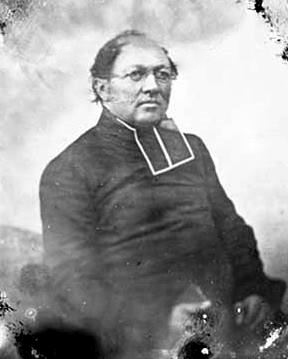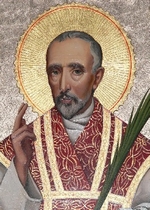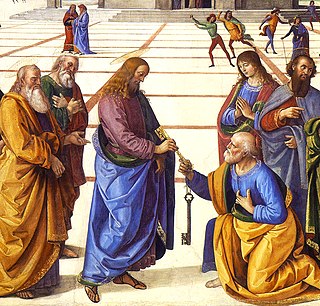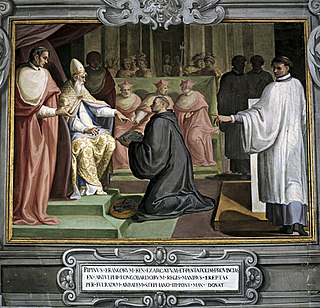Related Research Articles
Primate is a title or rank bestowed on some important archbishops in certain Christian churches. Depending on the particular tradition, it can denote either jurisdictional authority or (usually) ceremonial precedence.

Monsignor is a form of address or title for certain members of the clergy in the Catholic Church. Monsignor is the apocopic form of the Italian monsignore, meaning "my lord". "Monsignor" can be abbreviated as Mons. or Msgr. In some countries, the title "monsignor" is used as a form of address for bishops. However, in English-speaking countries, the title is unrelated to the episcopacy, though many priests with the title later become bishops.

Edmund Arrowsmith, SJ was one of the Forty Martyrs of England and Wales of the Catholic Church. The main source of information on Arrowsmith is a contemporary account written by an eyewitness and published a short time after his death. This document, conforming to the ancient style of the "Acts of martyrs" includes the story of the execution of another 17th-century recusant martyr, Richard Herst.

Joseph Crétin was the first Roman Catholic Bishop of Saint Paul, Minnesota. Cretin Avenue in St. Paul, Cretin-Derham Hall High School, and Cretin Hall at the University of St. Thomas are named for him.
George Nichols was an English Catholic martyr.

John Southworth was an English Catholic martyr. He is one of the Forty Martyrs of England and Wales.
Raymond Bonal (1600–1653) was a founder of the Congregation of the Priests of St. Mary (Bonalists), a Catholic religious order active in France in the sixteenth and seventeenth centuries.

David Lewis, S.J. was a Jesuit Catholic priest and martyr who was also known as Charles Baker. Lewis was canonized by Pope Paul VI in 1970 as one of the Forty Martyrs of England and Wales and is venerated as a saint in the Catholic Church. His feast day is celebrated on 27 August.

Arthur Bell, OFM was an English Franciscan martyr. He was found guilty of being a Roman Catholic priest by a court sitting under the auspices of Parliament during the English Civil War. He was executed at Tyburn in London. Bell was beatified by Pope John Paul II on 22 November 1987.
Robert Whitty was an Irish Jesuit priest.
Thomas Atkinson was an English Roman Catholic priest. He is a Catholic martyr, beatified in 1987.

Thomas Tichborne was an English Roman Catholic priest. He is regarded as a Catholic martyr.

Papal appointment was a medieval method of selecting the Pope. Popes have always been selected by a council of Church fathers; however, Papal selection before 1059 was often characterized by confirmation or nomination by secular European rulers or by the preceding pope. The later procedures of the Papal conclave are in large part designed to prohibit interference of secular rulers, which to some extent characterized the first millennium of the Roman Catholic Church, e. g. in practices such as the creation of crown-cardinals and the claimed but invalid jus exclusivae. Appointment may have taken several forms, with a variety of roles for the laity and civic leaders, Byzantine and Germanic emperors, and noble Roman families. The role of the election vis-a-vis the general population and the clergy was prone to vary considerably, with a nomination carrying weight that ranged from nearly determinative to merely suggestive, or as ratification of a concluded election.

The Oaten Hill Martyrs were Catholic Martyrs who were executed by hanging, drawing and quartering at Oaten Hill, Canterbury, on 1 October 1588. The gallows had been put up in 1576. These four were beatified by Pope Pius XI in 1929.

From 756 to 857, the papacy shifted from the influence of the Byzantine Empire to that of the kings of the Franks. Pepin the Short, Charlemagne, and Louis the Pious had considerable influence in the selection and administration of popes. The "Donation of Pepin" (756) ratified a new period of papal rule in central Italy, which became known as the Papal States.
The English College, Lisbon was a Roman Catholic seminary that existed from the 17th century to the 20th century.
Nicholas Woodfen born Nicholas Wheeler, also known as Nicholas Devereux, was an English Roman Catholic priest who was hanged, drawn and quartered at Tyburn, London on 21 January 1586. He is considered a Catholic martyr and one of the Eighty-five martyrs of England and Wales who were executed between 1584 and 1679. He was beatified on 22 November 1987 by Pope John Paul II.
Immaculate Heart of Mary Church, is a Catholic parish church in Cleveland, Ohio and part of the Diocese of Cleveland. It is a located on Lansing Ave. near East 66th St., in a part of the South Broadway neighborhood previously known as Warszawa, also referred to today as Slavic Village. Both the church and the area are GNIS named features. The church is in the neighborhood of, but not within, the area listed as Warszawa Neighborhood District on the National Register of Historic Places. The church, school, rectory, and convent buildings are listed together as a Cleveland Designated Landmark.
References
- Attribution
![]() This article incorporates text from a publication now in the public domain : Herbermann, Charles, ed. (1913). "Paul Atkinson of St. Francis". Catholic Encyclopedia . New York: Robert Appleton Company.
This article incorporates text from a publication now in the public domain : Herbermann, Charles, ed. (1913). "Paul Atkinson of St. Francis". Catholic Encyclopedia . New York: Robert Appleton Company.